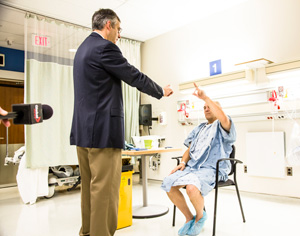
Pictured above (right) is Tony Lightfoot, a retired mechanical engineer from Calgary, who received revolutionary scalpel-free surgery to alleviate chronic tremors.
Until recently, patients suffering from chronic tremors in their arms and hands had few options to alleviate the symptoms of this debilitating movement disorder.
But, in a Canadian first, Dr. Andres Lozano, a neurosurgeon at the Krembil Neuroscience Centre and a team of co-investigators at Sunnybrook Health Sciences Centre, have pioneered a procedure using MRI-guided focused ultrasound to successfully treat patients with disabling tremors.
How it works
Similar to focusing the heat of the sun through a magnifying glass, the technology allows investigators to focus ultrasound waves under MRI guidance through a patient's skull to reach an area located deep in the brain.
Once that area has been located, the 1,024 focused ultrasound waves are delivered to a focal target over 10 seconds to destroy the neurons that are responsible for the tremor.
'Scalpel-free'
This outpatient procedure is described as "scalpel-free surgery" since there is no incision. There is no general anesthetic required, the patient remains awake and alert during treatment and can go home the next day.
Since no incision is made and no device is implanted in the brain, there is no risk of bleeding in the brain or infection once the surgery is complete, greatly limiting the side-effects of the procedure.
Still in the early-stage clinical trial of the therapy, the procedure appears to be safe and is showing promising results with five patients having been treated so far in Canada.
The study is the result of collaboration between world leading experts in movement disorder surgery at the Krembil Neuroscience Centre at Toronto Western Hospital as well as ultrasound physics and radiosurgery at Sunnybrook Health Sciences Centre and University of Toronto.
'Dramatic' improvement
"There was a clearly visible and dramatic improvement in tremor in the patient cases seen so far," says Dr. Lozano, a co-investigator of the study. "Improvement in the dominant hand is seen while the patient is still in the MRI scanner. Three months post-procedure there were significant improvements in activities such as writing and drinking from a cup, which were not possible prior to surgery."
On December 18, 2012, for the first time in Canada, Dr. Lozano and his colleagues performed the procedure on Tony Lightfoot, a retired mechanical engineer from Calgary who had been suffering from essential tremor for 20 years. Essential tremor is the most common movement disorder and is often resistant to medical treatment.
A significant portion of patients with the condition have reduced quality of life related to impairment in the use of their dominant hand for eating, drinking, writing and other activities requiring fine movements.
Patient amazed
For Mr. Lightfoot, the results of the procedure were immediate. After receiving the therapy, he was able to take a sip of water from a cup held by a now steady hand. "That is fantastic. Fantastic," he said. "I never thought it would happen."
The procedure, already considered revolutionary for its promising results, may eventually lead to a new treatment option for other movement disorders and even brain tumours.
Related Stories
